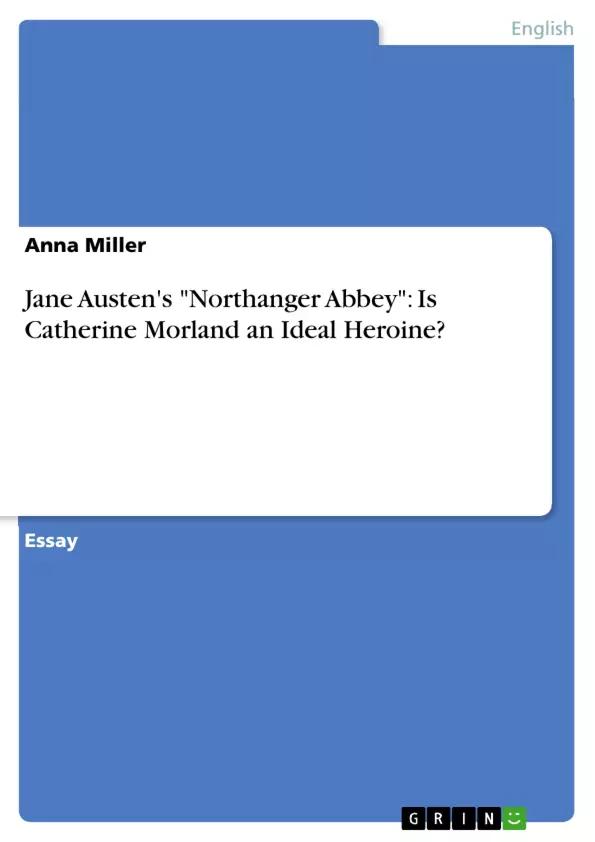Content
I. Introduction
II. Analysis and Interpretation
1. Catherine's Qualifications
2. Catherine's Weaknesses
III. Conclusion
IV. Bibliography
I. Introduction
In the British fiction of the nineteenth century female protagonists were especially outstanding and
not only used by Jane Austen, who wrote about Elizabeth Bennet, Emma Woodhouse or Catherine
Morland, just to name a few of them, but also by Sir Walter Scott with his heroine Jeanie Deans (cf.
Morgan 559). Many other authors of the nineteenth century chose a heroine as a main character and
not a hero, even if there are very well men participating in the story, but they only have a minor role
and represent the counterpart to the women (cf. Morgan 559).
Now the question may arise why especially in that century women played the major role in
the novels whereas before and after that the protagonists had mostly been male (cf. Morgan 560).
(...)Instead, it is
to take a closer look at one of these heroines, which is Catherine Morland. The aim of this work is
to decide whether she is an ideal heroine or not. To come to a decision it is necessary to analyse her
character as well as her actions.
Since the whole story, as well as all the other protagonists, are set around her, the reader gets
to know how Catherine feels, how she thinks, and especially learns a lot about her likes and
dislikes. We do not get as much information about other characters as we get about Catherine. But if
we look closer at the person of Catherine, it becomes questionable whether it is justified to award
the title of an ideal heroine to her. The reader accompanies her through her whole stay in Bath and
Northanger Abbey and has a chance to observe her behaviour in crucial situations. This observation
is often bilateral, as on the one hand we can see the self-confident girl travelling on her own, and on
the other hand her childish behaviour and her naivete point out that she is not yet a grown-up. This
becomes notably evident when we compare her to the other characters in the novel.
Nevertheless, this has to be analysed in detail in order to make a fair decision. In the
following passages I would therefore firstly like to illustrate to what extend one can call Catherine
an ideal heroine, what her strengths are and when she might be superior to other persons, and
secondly, this should be contrasted to the attributes which disqualify her to be labelled such in
regard to the weak points in her character and behaviour.
Inhaltsverzeichnis (Table of Contents)
- I. Introduction
- II. Analysis and Interpretation
- 1. Catherine's Qualifications
- 2. Catherine's Weaknesses
- III. Conclusion
- IV. Bibliography
Zielsetzung und Themenschwerpunkte (Objectives and Key Themes)
This paper aims to analyze Catherine Morland's character and actions to determine if she is an ideal heroine in Jane Austen's *Northanger Abbey*. The work investigates Catherine's personality traits, her experiences in Bath and Northanger Abbey, and compares her behavior to other characters in the novel.
- Catherine's Character Traits
- Catherine's Experiences in Bath and Northanger Abbey
- Comparison of Catherine's Behavior to Other Characters
- Catherine's Journey from Childhood to Adulthood
- The Role of Society and Social Expectations in Shaping Catherine's Development
Zusammenfassung der Kapitel (Chapter Summaries)
The introduction establishes Catherine Morland as a young woman navigating the complexities of society in early 19th century England. The paper explores the role of female protagonists in 19th century literature, highlighting the prominence of heroines in the works of Austen and other authors. The analysis focuses on Catherine's character, exploring her strengths, weaknesses, and experiences in Bath and Northanger Abbey.
The chapter "Catherine's Qualifications" examines Catherine's positive attributes. Despite her youth and lack of experience, Catherine is brave and independent. Her upbringing, which included three older brothers, contributed to her self-confidence and resilience. The chapter explores how Catherine's adventurous spirit and willingness to embrace new experiences position her as a typical Austen heroine. The chapter also highlights Catherine's honesty, conscience, and her ability to learn and adapt to societal expectations. The discussion contrasts her personality to those of Isabella and Mrs. Allen, further emphasizing her positive qualities.
Schlüsselwörter (Keywords)
The main keywords for this text include: Jane Austen, *Northanger Abbey*, Catherine Morland, ideal heroine, character analysis, female protagonists, 19th century literature, societal expectations, childhood, adolescence, independence, honesty, conscience, adaptation, social graces, Bath, Northanger Abbey.
- Quote paper
- Anna Miller (Author), 2011, Jane Austen's "Northanger Abbey": Is Catherine Morland an Ideal Heroine?, Munich, GRIN Verlag, https://www.grin.com/document/197065



